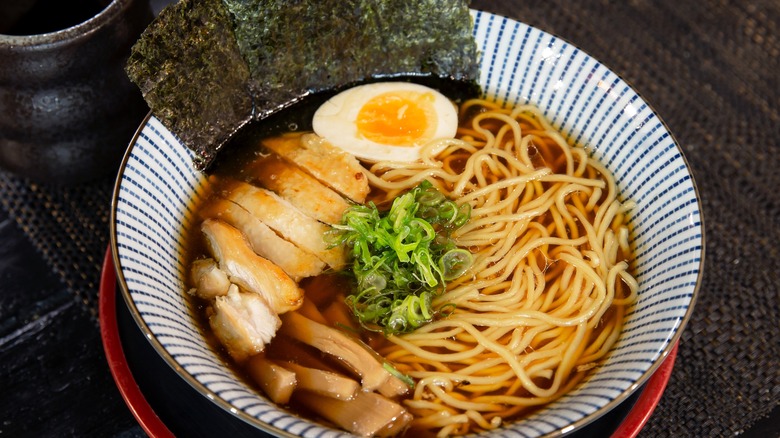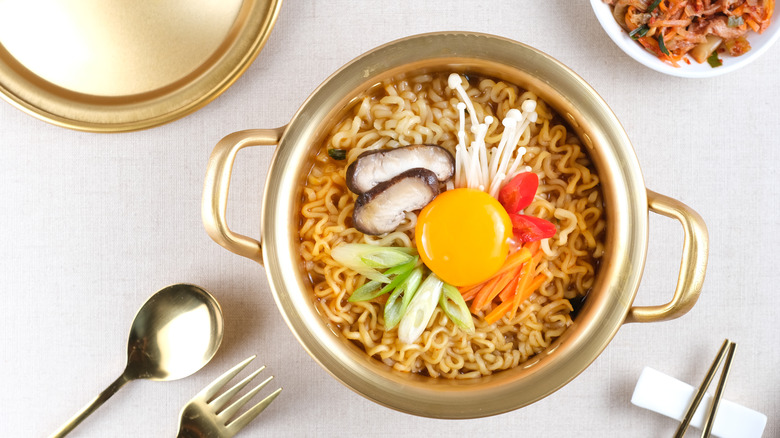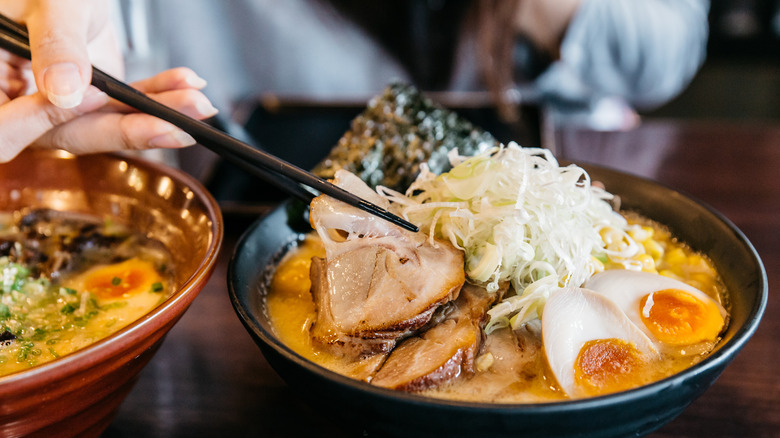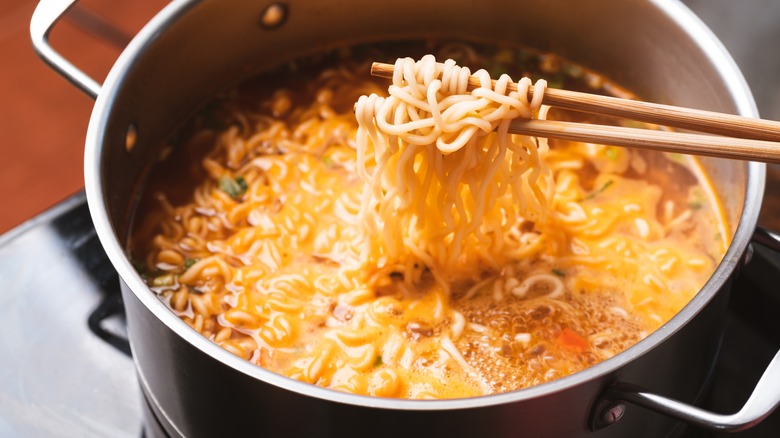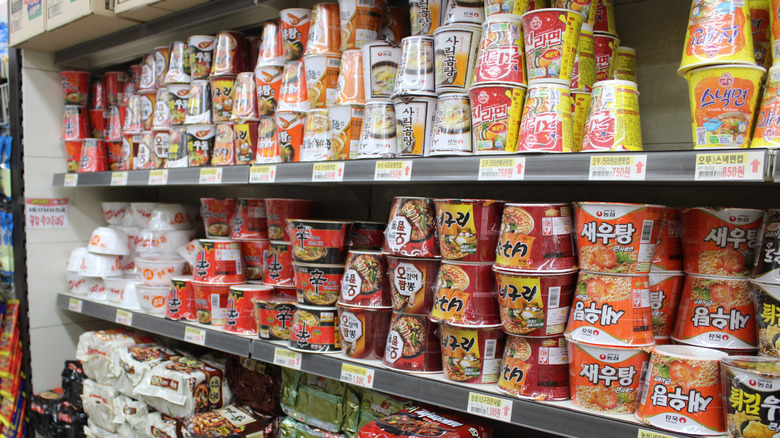Ramen Vs. Ramyun: What's The Difference?
Not so long ago, most Americans associated the word ramen with a package of dried noodles including a little seasoning packet. Nowadays, most people know that traditional ramen has a rich broth with dense noodles and a variety of toppings — such as meat, mushrooms, and eggs. Those familiar with authentic Japanese ramen may have also come across the word ramyun and wondered at the difference. Could it be explained as simply as two different spellings for the same dish?
The answer is that ramyun (also spelled ramyeon) is actually a Korean dish and is always made from the cheap instant noodle packets found on store shelves. The instant noodle packets made by Korean companies have little in common with those from Japan, according to Be Korea. While ramen (and ramyun) are both widely eaten in Japan and Korea, this style of noodles was invented by Chinese immigrants living in Japan. It wasn't until the 1960s that this instant format of ramen became popular in Korea (via Stars and Stripes Korea). Now, Korea is the leading consumer of ramen, with each person eating about 80 packages per year.
Different preparation techniques
Traditional Japanese ramen can take hours to make, while Korean ramyun takes just a few minutes, per Lingua Asia. However, both countries enjoy the instant version of ramen that is sold in grocery stores. It's as simple as boiling the noodles and adding the seasoning packet, with the option of sprucing it up with toppings. In Japan, ramen is often sold at dedicated ramen restaurants, but in Korea, there really aren't any ramyun restaurants, according to Be Korea. If you find ramyun at a restaurant, it's served as a snack or side dish.
That's a stark contrast to Japan, where ramen is much revered as a special culinary creation. According to Live Japan, customers have been known to wait for hours outside of restaurants where the ramen is made by a master chef. How ramen is made in Japan can depend on what region or city you are in, as many places have put their own spin on the dish.
The broth for ramen is largely standardized throughout Japan and is most commonly made from pork, chicken, beef, or fish bones. The broth is cooked for a very long time to help ensure that it's as flavorful as possible, and the final product can range from transparent to cloudy. But, similar to Korea, many Japanese also enjoy the convenience and speed of instant ramen.
Varying toppings
Ramyun is by definition just instant noodles with a packet of seasoning, but often additional toppings – such as eggs, cheese, and vegetables — are added, per Be Korea. The most common vegetables are spring onions, leaks, and carrots, with an egg that could be raw or semi-cooked. Cheese is a favorite topping for ramyun, according to Be Korea, which says it melts on top of the noodles. In fact, American cheese specifically is a popular topping for ramyun in Korea, where some of the culture's food has been influenced by the ingredients available after the Korean War — often from the American military bases. That's how Koreans began to use American cheese on a variety of items, including spicy cheese ramen (via Honest Food Talks). The heat of spicy ramyun is tempered by adding cheese, and then a creamier and thicker broth is created.
When it comes to adding toppings to traditional Japanese-style ramen, there are several common toppings that are expected, according to MasterClass. They are fatty pork belly, green onions, bean sprouts, sheets of dried seaweed, and bok choy. Additionally, the soft-boiled egg often found on top of a bowl of ramen is no ordinary egg. According to Ramen Museum New York, this type of egg — called ajitama — is soft-boiled and marinated in soy sauce and mirin for a few hours, or for a few minutes with the proper egg marinating hacks.
Curly to straight noodles
The noodles used in authentic Japanese ramen and served in restaurants are Chinese-style wheat noodles, according to Live Japan. Over time, those firm and chewy Chinese-style noodles have evolved, says Japanese Cooking 101. Having this type of hearty noodles is important for ramen because more delicate noodles would become soggy from sitting in the broth. In addition, ramen noodles are created with a specific technique using kansui, which is a salty alkaline liquid. This liquid is mixed with the flour and other ingredients to create the essential ramen noodle (via Live Japan). However, the texture and shape of the noodles used in ramen vary and can be thin, thick, curly, or straight.
For both instant ramen and ramyun, the dry noodles are usually made from wheat flour, vegetable oils, and flavorings, reports Healthline. The reason they can be considered instant is because the noodles have been steamed cooked and then air-dried or fried before being packaged. Most varieties contain noodles that become curly when cooked; however, there are instant varieties of udon as well, which is different than ramen but available in similar varieties.
Different varieties
Ramen and ramyun come in many varieties. When considering the dried version of ramyun sold in South Korea, there are dozens of kinds to choose from. They include the popular Nongshim Shin Ramyeon, which has two main flavor profiles — a spicy soup and a heartier option with ox bone soup (via Be Korea). There are also ramyun variations based on classic Korean dishes, such as Nongshim Budae Jjigae Ramyeon, which is similar to budae jjigae, an army base stew, and Samyang Buldak Bokkeum Myeon, which incorporates the taste of buldak — or fire chicken.
There are four main styles of ramen, but just like ramyun, there are many different varieties. The most popular type of traditional ramen in Japan, according to MasterClass, is the shoyu style of ramen that features a soy sauce flavored soup base. There is also miso ramen, which boasts a miso-flavored soup base, and tonkotsu ramen, which is made with a pork bone broth. Live Japan lists 16 different regional varieties of ramen, from the Sapporo ramen in the northern part of Japan to the Tokyo-style ramen in the center of the country. Sapporo ramen is a miso-based variation that is served with butter, corn, sprouts, and sometimes seafood (via Live Japan). This is a heartier version of ramen suitable for the winters of the north. Whereas, the regional ramen of Tokyo uses a chicken-based broth and has thin and curly noodles with toppings like nori, menma, egg, and pork.
